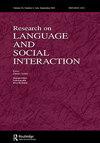Designing Talk for Humans and Horses: Prosody as a Resource for Parallel Recipient Design
IF 3
1区 文学
Q1 COMMUNICATION
引用次数: 2
Abstract
ABSTRACT This analysis shows how, in horse-riding lessons, riding instructors use prosody and other sound patterns to design their talk for human and equine recipients at the same time, while orienting to distinct contributions from each. Practices for doing so include nonlexical vocalizations, marked prosodic delivery, and conventionalized lexical-prosodic bundles. Parallel recipient design allows turn-holders to pursue a single activity that is to be performed jointly by the recipient pair. Parallel recipient design is shown to be distinct from alternating recipient design, to be found during multiactivity. Parallel recipient design can be delivered consecutively, with talk designed to mobilize the rider followed by talk designed to mobilize the horse; or simultaneously, with lexical items performing one action to the rider and their prosodic delivery performing another action to the horse. The data are recordings of naturally occurring horse-riding lessons, mostly in English; some data are in German, with English translations.为人类和马设计谈话:韵律作为并行接受者设计的资源
本文分析了在马术课程中,马术教练如何使用韵律和其他声音模式来同时为人类和马的接受者设计他们的谈话,同时针对每个人的不同贡献。这样做的实践包括非词汇发声,标记韵律传递和约定俗成的词汇韵律束。并行接收者设计允许回合持有者追求由接收者对共同执行的单一活动。平行接受者设计被证明是不同于交替接受者设计,发现在多活动。平行的接受者设计可以连续地传递,先用说话来调动骑手,然后用说话来调动马匹;或者同时,词汇项目对骑手执行一个动作,而它们的韵律传递对马执行另一个动作。这些数据是自然发生的骑马课程的录音,大部分是英语的;部分资料为德文,并附有英文翻译。
本文章由计算机程序翻译,如有差异,请以英文原文为准。
求助全文
约1分钟内获得全文
求助全文
来源期刊
CiteScore
7.30
自引率
7.40%
发文量
20
期刊介绍:
The journal publishes the highest quality empirical and theoretical research bearing on language as it is used in interaction. Researchers in communication, discourse analysis, conversation analysis, linguistic anthropology and ethnography are likely to be the most active contributors, but we welcome submission of articles from the broad range of interaction researchers. Published papers will normally involve the close analysis of naturally-occurring interaction. The journal is also open to theoretical essays, and to quantitative studies where these are tied closely to the results of naturalistic observation.

 求助内容:
求助内容: 应助结果提醒方式:
应助结果提醒方式:


